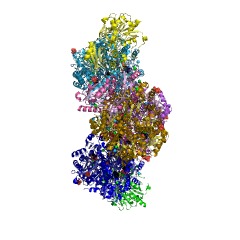| Synonyms |
CAD, CAD carbamoyl-phosphate synthetase, CAD protein, Carbamoyl phosphate synthase (glutamine), carbamoyl phosphate synthetase, Carbamoyl phosphate synthetase (glutamine-hydrolyzing), carbamoyl phosphate synthetase 1, carbamoyl phosphate synthetase II, carbamoyl phosphate synthetase III, carbamoyl-phosphate synthetase, Carbamoyl-phosphate synthetase (glutamine-hydrolysing), carbamoyl-phosphate synthetase 2, Carbamoylphosphate synthase, Carbamoylphosphate synthetase, Carbamoylphosphate synthetase II, Carbamyl phosphate synthetase (glutamine), Carbamyl phosphate sythetase II, carbamylphosphate synthetase – aspartate transcarbamylase, CPA2, CPS, CPS II (glutamine-dependent), CPS III, CPS III (glutamine- and N-acetyl-L-glutamine-dependent), CPS1, CPSase, CPSase type II, CPSase-A, CPSase-P, CPSII, EC 2.7.2.9, Glutamine-dependent carbamyl phosphate synthetase, glutamine-hydrolyzing CPSase, MGG_04503, More, MtCPSs1, MtCPSs2, Synthase, carbamoylphosphate (glutamine), Synthetase, carbamoylphosphate (glutamine-hydrolyzing) |
| Comments |
The product carbamoyl phosphate is an intermediate in the biosynthesis of arginine and the pyrimidine nucleotides [4]. The enzyme from?Escherichia coli?has three separate active sites, which are connected by a molecular tunnel that is almost 100 ? in length [8]. The amidotransferase domain within the small subunit of the enzyme hydrolyses glutamine to ammonia via a thioester intermediate. The ammonia migrates through the interior of the protein, where it reacts with carboxyphosphate to produce the carbamate intermediate. The carboxyphosphate intermediate is formed by the phosphorylation of hydrogencarbonate by ATP at a site contained within the N-terminal half of the large subunit. The carbamate intermediate is transported through the interior of the protein to a second site within the C-terminal half of the large subunit, where it is phosphorylated by another ATP to yield the final product, carbamoyl phosphate [6].?cf. EC?6.3.4.16, carbamoyl-phosphate synthase (ammonia). |

